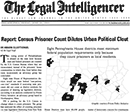Fixing prison-based gerrymandering after the 2010 Census: Pennsylvania
50 State Guide, March 2010
- Sections
- Impact at the state level
- Pennsylvania law says a prison cell is not a residence
- Pending legislation
- Other solutions
- Additional resources
Prison-based gerrymandering violates the constitutional principle of "One Person, One Vote." The Supreme Court requires districts to be based on equal population in order to give each resident the same access to government. But a longstanding flaw in the Census counts incarcerated people as residents of the prison location, even though they can’t vote and aren’t a part of the surrounding community.
When legislators claim people incarcerated in their districts are legitimate constituents, they award people who live close to the prison more of a say in government than everybody else.
Impact at the state level:
- Without using prison populations as padding, 8 Pennsylvania districts drawn after the 2000 Census did not meet constitutional population requirements.
- For example, each Senate district in Pennsylvania should have had 60,498 residents. District 85, in Union and Snyder counties, claimed the populations of 2 large prisons, however, and had only 55,968 actual residents. This means that every group of 92 residents in District 85 has the same voting power as 100 people elsewhere in state.
- Crediting all of Pennsylvania’s incarcerated people to a few locations, far from home, enhances the political clout of the people who live near prisons, while diluting voting power of all other Pennsylvanians.
Pennsylvania law says a prison cell is not a residence:
- “For the purpose of registration and voting, no individual shall be deemed to have gained a residence by reason of presence or lost a residence by reason of absence… [while] in an institution at public expense.” (25 Pennsylvania Consolidated Statutes §1302(a)(1)(iii).)
Pending legislation (as of March 2010):
- A Resolution urging the United States Census Bureau to change its policy of recording the residence of incarcerated persons from the location of the correctional facilities to the last known home address of such persons, introduced by Representatives Cruz, Youngblood, Parker and Siptroth, January 20, 2010.
Other solutions:
- Ideally, the U.S. Census Bureau would change where it counts incarcerated people. They should be counted as residents of their home — not prison — addresses. There is no time for that in 2010, but Pennsylvania should ask the Census Bureau for this change for 2020.
- After the 2010 Census, the state and its local governments should, to the degree possible, count incarcerated people as residents of their home communities for redistricting purposes. Where that is not feasible, incarcerated people should be treated as providing unknown addresses instead of being used to pad the legislative districts that contain prisons.
Additional resources:
- Importing Constituents: Prisoners and Political Clout in Pennsylvania, is a district-by-district analysis of prison-based gerrymandering in Pennsylvania state legislative districts.
- Pennsylvania voting rules explain prisoner residence, by Peter Wagner, about a Secretary of State voting rights pamphlet.
 Report: Census Prisoner Count Dilutes Urban Political Clout By Amaris Elliott-Engel, The Legal Intelligencer, June 26, 2009
Report: Census Prisoner Count Dilutes Urban Political Clout By Amaris Elliott-Engel, The Legal Intelligencer, June 26, 2009- A list of new large prisons built in Pennsylvania since the 2000 Census. These prisons are likely to create new prison-based gerrymandering problems after their populations are counted in the 2010 census.
Events
- August 5, 2024:
On Wednesday, August 5, 2024, at 3 PM EST, we’ll host a panel of advocates to discuss the importance and challenges of helping people in prison testify at legislative hearings, and introduce our new legislative testimony toolkit.
Panelists include: Anthony Blakenship of Civil Survival, Jesse White of Prisoners’ Legal Services of Massachusetts, and incarcerated journalist Christopher Blackwell.
Register here.
Not near you?
Invite us to your city, college or organization.
 Report: Census Prisoner Count Dilutes Urban Political Clout
Report: Census Prisoner Count Dilutes Urban Political Clout


